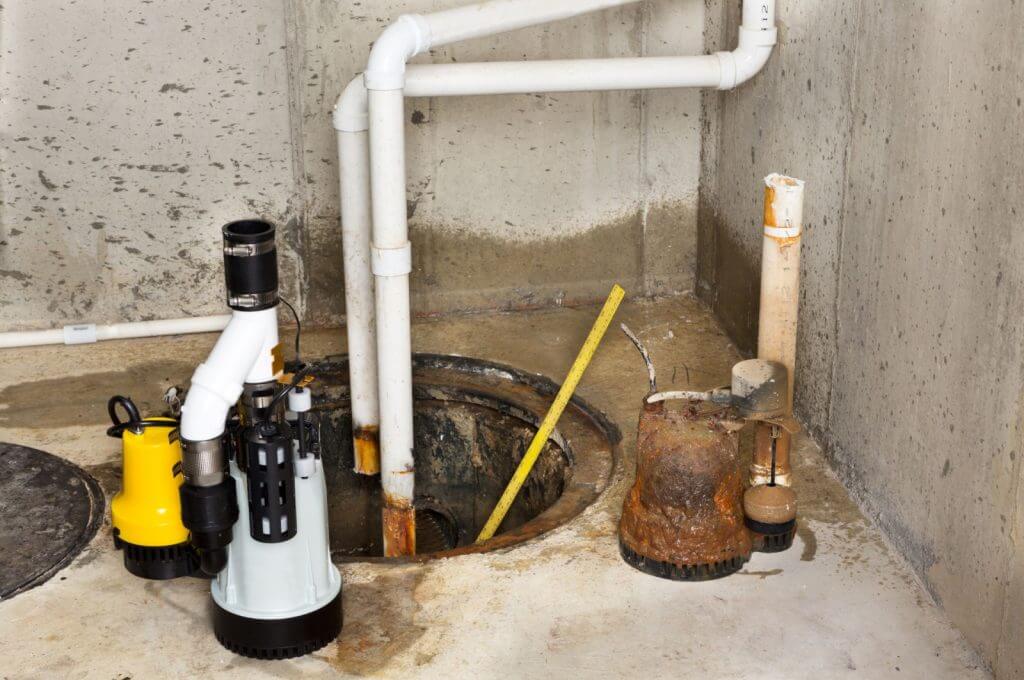Find A Plumber Near You
Call Us Now:

There are four main sump pump switch types—tethered, vertical, diaphragm, and electronic—that all share a common purpose: keeping your basement dry!
They all work by detecting water levels in the sump pit and turning on the pump to prevent flooding. However, the process through which they do this differs and some are better suited for different basins. Proper selection, installation, and maintenance are key to ensuring your sump pump works as intended to protect your home.
Keep reading to learn more about the different types of sump pump switches!
A tethered sump pump switch has a buoyant float attached to the pump via a flexible cord. As water levels rise in the sump pit, the float ascends and activates a switch mechanism. This tells the pump to turn on and start pumping water out of the pit. Once the water (and float) descends to a predetermined level, the switch deactivates to halt the pump.
These types of sump pump switches are best for wide, deep basins.
The float switch can get stuck on the pump or the side of its basin, while the cord can easily get tangled—both of which can lead to flooding! Incorrect float adjustments can also lead to premature activation that wears out the sump pump motor.
🔧 Read more: What To Do If Your Basement Floods
Vertical sump pump float switch types have a float attached to a vertical stem. As water levels rise, the float ascends along the stem until it reaches a designated height at which it triggers the ‘on’ switch positioned at the top. The float then descends as water levels lower, eventually deactivating the pump upon reaching a certain level.
A vertical switch is typically best for small, shallow basins.
Debris can crowd or even puncture the float, which will cause it to sink and not work as intended. The steel rod getting stuck is also common and will lead to the pump running continuously. These sump switches are not for managing heavy rain.
 Image source: Canva
Image source: Canva
A diaphragm switch relies on water pressure to detect water levels. As water pressure rises, the diaphragm compresses and triggers the switch to activate the pump. Once the pressure drops, the diaphragm re-expands and signals for the pump to turn off.
These types of sump pump switches are ideal for congested basins with minimal space.
Over time, the diaphragms can fail to operate as they become brittle, thus becoming unresponsive to elevated water pressure. Debris such as pebbles and sticks can also get stuck inside the switch, preventing it from working. The pump cycle length is also not adjustable so you have to buy the right switch for your basin the first time!
🔧 Read More: How Does a Sump Pump Work?
Electronic switches use internal water level sensors to trigger the pump switch when a designated limit is reached. The pump will then activate and drain the pit. Once the sensor detects the water level has lowered, it will deactivate the pump.
These sump pump switch types are versatile and work for all basins.
The sensors can become contaminated with limescale over time, resulting in inaccurate readings that trigger the pump unnecessarily. These kinds of switches also require electricity and won’t work during power outages unless you have a backup power supply.
 Image source: Canva
Image source: Canva
Ultimately, when it comes to different types of sump pump switches, determining which is right for your pump will depend on your unit and needs. Here’s a summary:
| Type | Pros | Cons |
|---|---|---|
| Tethered Float Switch | ✅ Easy to install ✅ Cord length can be adjusted for longer pump cycles |
❌ Float can be punctured and sink with water ❌ Only for wide basins ❌ Cords and the float can get tangled in debris |
| Vertical Float Switch | ✅ Easy to install ✅ Ideal for narrow basins |
❌ Float can be punctured and sink with water ❌ Rod can get stuck in place |
| Diaphragm Switch | ✅ Activated by pressure ✅ Great for congested basins with minimal space |
❌ Not adjustable ❌ Bladder gets easily worn out; short lifespan |
| Electronic Switch | ✅ Activated by sensors ✅ Less prone to wear and tear ✅ Takes up very little space |
❌ Inoperable in power outages ❌ Limescale buildup can cause inaccurate readings |
Understanding sump pump float switch types is important if you’re buying a new pump or a replacement part. However, knowing about switches isn’t the same as knowing how to fix them when issues arise—that’s where we come in!
The professional team of plumbers at 1st Rooter is experienced in fixing all sump pump switch types. From vertical to electronic float switches, you can count on us to get yours up and running again if you encounter problems. We also conduct regular maintenance checks if you want to be proactive and avoid issues altogether.
Need help with your sump pump? Make us your first choice!
Leave A Reply